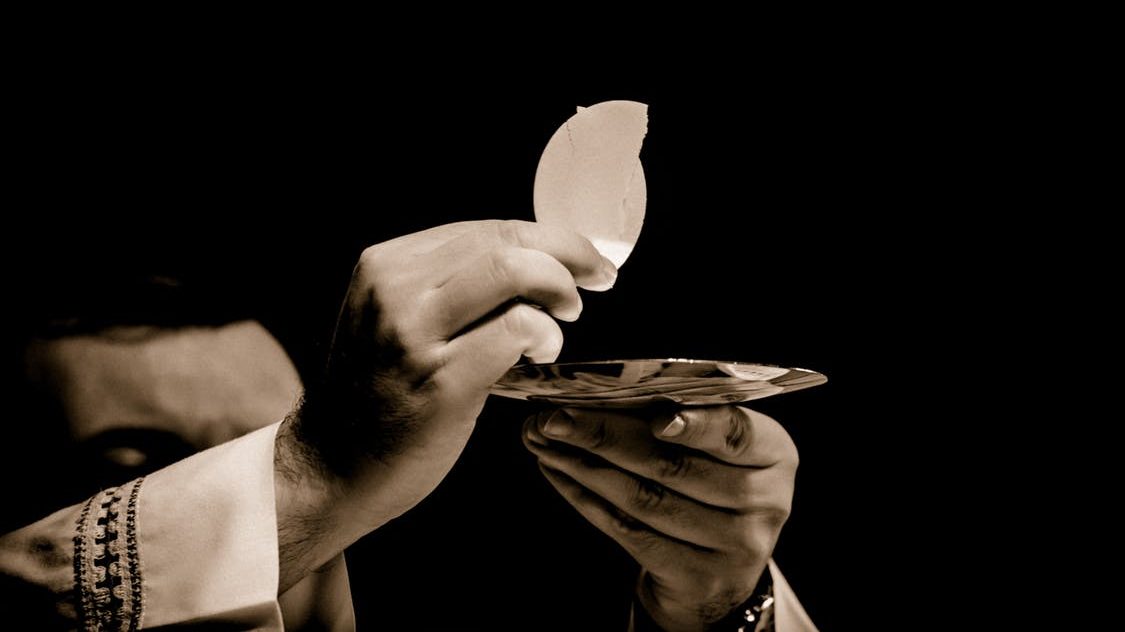Eucharistic Prayer I
Next in our examination of the forthcoming third edition of the Roman Missal, to be introduced this Advent, we will look at the Institution Narrative from Eucharistic Prayer I, also called the Roman Canon. First is the current translation we are all familiar with. Beneath that is the Latin – I want to point out this is the Latin from the second edition of the Roman Missal, currently in effect. And finally is the new translation from the third edition we will be receiving this Advent.
Current Translation
The day before he suffered he took bread in his sacred hands and looking up to heaven, to you, his almighty Father, he gave you thanks and praise. He broke the bread, gave it to his disciples, and said:
TAKE THIS, ALL OF YOU, AND EAT IT; THIS IS MY BODY WHICH WILL BE GIVEN UP FOR YOU.
When supper was ended, he took the cup. Again he gave you thanks and praise, gave the cup to his disciples, and said: TAKE THIS, ALL OF YOU, AND DRINK FROM IT; THIS IS THE CUP OF MY BLOOD, THE BLOOD OF TH ENEW AND EVERLASTING COVENANT. IT WILL BE SHED FOR YOU AND FOR ALL SO THAT SINS MAY BE FORGIVEN. DO THIS IN MEMORY OF ME.
Latin Original
Qui, pridie quam paterétur, accépit panem in sanctas ac venerábiles manus suas, et elevates óculis in caelum ad te Deum Patrem suum omnipoténtem, tibi grátias agens benedíxit, fregit, dedítgue discípulis suis, dicens: ACCÍPITE ET MANDUCÁTE EX HOC OMNES: HOC EST ENIM CORPUS MEUM, QUOD PRO VOBIS TRADÉTUR.
Símili modo, postquam cenátum est, accípiens et hunc praeclárum cálicem in sanctas ac venerábiles manus suas, item tibi grátias agens benedíxit, dedítque discípulis suis, dicens: ACCÍPITE ET BÍBITE EX EO OMNES: HIC EST ENIM CALIX SÁNGUINIS MEI, NOVI ET AETÉRNI TESTAMÉNTI, QUI PRO VOBIS ET PRO MULTIS EFFUNDÉTUR IN REMISSIÓNEM PECCATÓRUM. HOC FÁCITE IN MEAN COMMEMORATIÓNEM.
New Translation
On the day before he was to suffer he took bread in his holy and venerable hands, and with eyes raised to heaven to you, O God, his almighty Father, giving you thanks he said the blessing, broke the bread and gave it to his disciples, saying: TAKE THIS, ALL OF YOU, AND EAT OF IT: FOR THIS IS MY BODY WHICH WILL BE GIVEN UP FOR YOU.
In a similar way, when supper was ended, he took this precious chalice in his holy and venerable hands, and once more giving you thanks, he said the blessing and gave the chalice to his disciples, saying: TAKE THIS, ALL OF YOU, AND DRINK FROM IT: FOR THIS IS THE CHALICE OF MY BLOOD, THE BLOOD OF THE NEW AND ETERNAL COVENANT, WHICH WILL BE POURED OUT FOR YOU AND FOR MANY FOR THE FORGIVENESS OF SINS. DO THIS IN MEMORY OF ME.
The first thing you may notice at a glance is that the new translation is a bit longer. There are certain elements of the original which have been missing from our current translation, and just to point them out to you, I’ve highlighted some phrases in the new translation, and the corresponding Latin text, which are completely absent from what we have now.
And again, I want to underscore that the Latin we are looking at is the normative text in effect now. This is the definitive and official text of the ordinary form of the Roman Rite. The part that jumps right out at me is the phrase “holy and venerable hands” which occurs twice to describe the hands of Christ as He instituted the Eucharist. It’s there in the Latin: sanctas ac venerabiles manus. What a wonderful phrase describing the saving hands of our Saviour, about to offer Himself up for us! Why has it been missing from our English Mass all these years? I’m thankful it is being restored.
In a similar way, we will now be referring to the vessel that Christ used to institute the Sacrament of His Blood at the Last Supper as a “precious chalice” rather than simply a “cup.” How befitting it is to be able to hear this more exalted language used to describe some of the most vital elements of our faith, things which indeed should be “precious” and “venerable” to us!
I have read that when the early translations of the Mass into English were being made in the 1970s, the emphasis was on making the language as simple and easy to understand as possible. I sympathize with the desire to make the liturgy accessible to the greatest number of people. However, it is a fine line between making the language “simple” and “talking down to” someone. I think the great majority of English speakers will readily understand the significance of phrases such as “holy and venerable,” and if they do not immediately, they will soon rise to the occasion. We should at least give them that opportunity!
Finally we must deal with the issue of “for all” v. “for many,” which is the change in the Roman Canon which has generated the most controversy. First of all we must make clear that the Church unequivocally teaches that Christ died for all men, without exception. “There is not, never has been, and never will be a single human being for whom Christ did not suffer” (Council of Quiercy, 853, qtd. in CCC 605). So why the change from “all” to “many,” then?
First, it is a better translation of the Latin pro multis, which has always been the official text. So in that respect it is not truly a change but a more accurate rendition of what the prayer has always said. So the question then is why does it say “for many” in the original Latin? And the answer is because it is Scriptural. Christ Himself said plainly that He would “give His life as a ransom for many” (Mt. 20:28, cf. Rom. 5:18-19). The Catechism teaches that this phrase is not meant to be limiting, but rather to highlight the contrast between the large multitude of humanity with the unique and singular person of Jesus Christ, who dies to save us (CCC 605).

